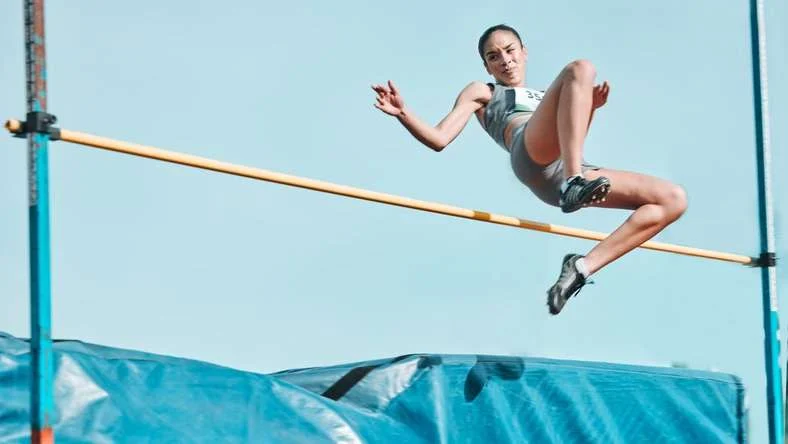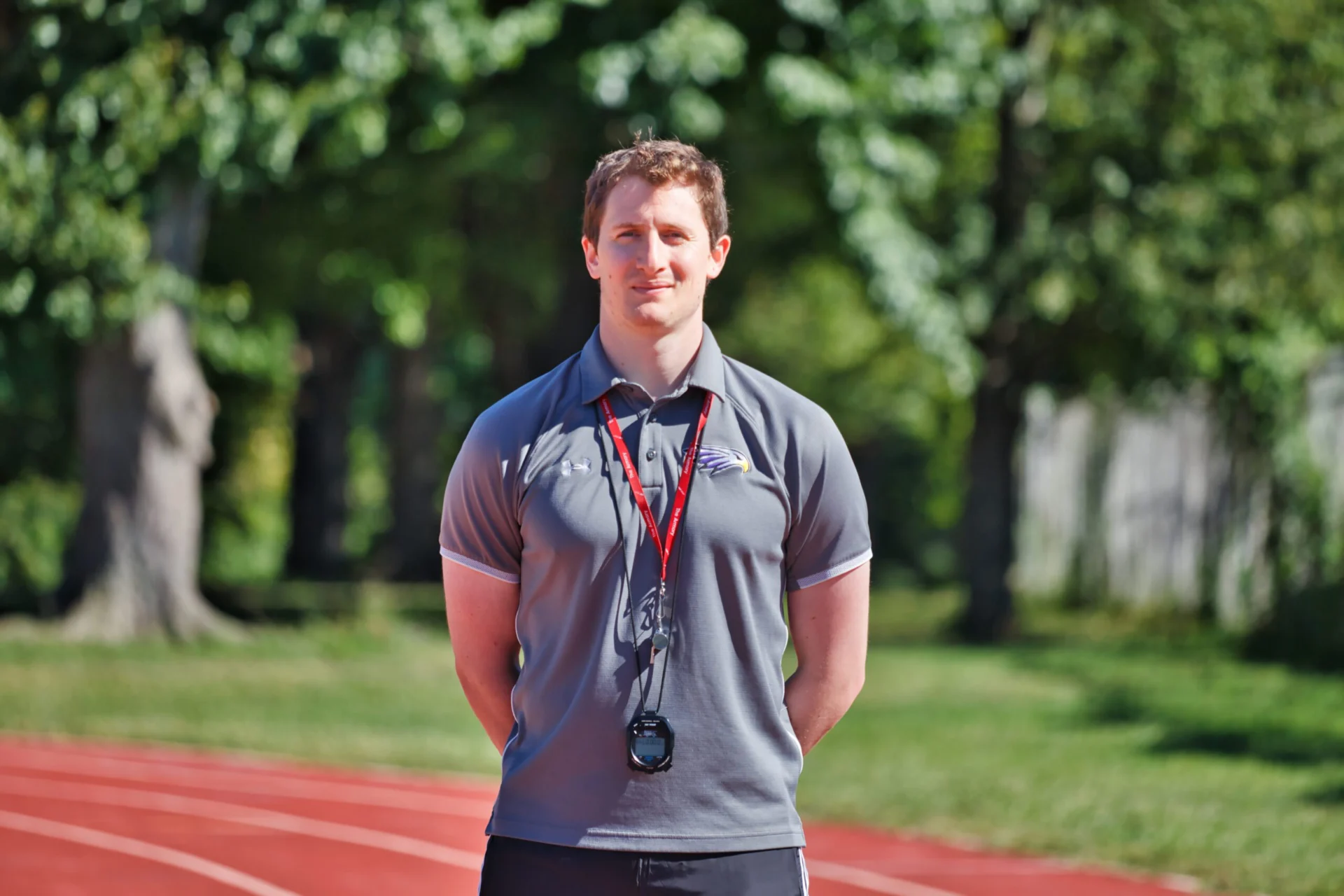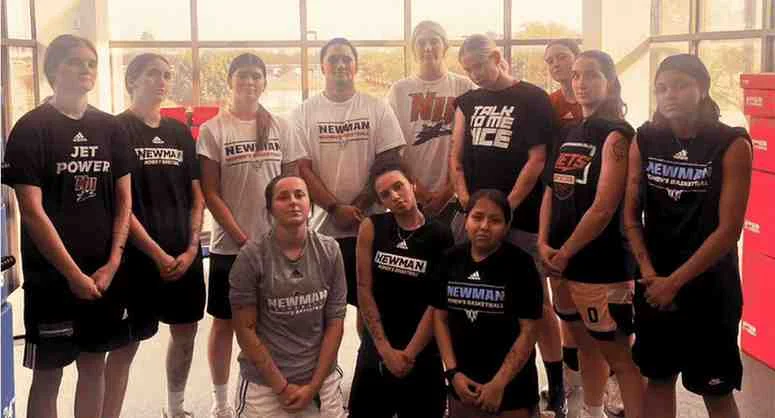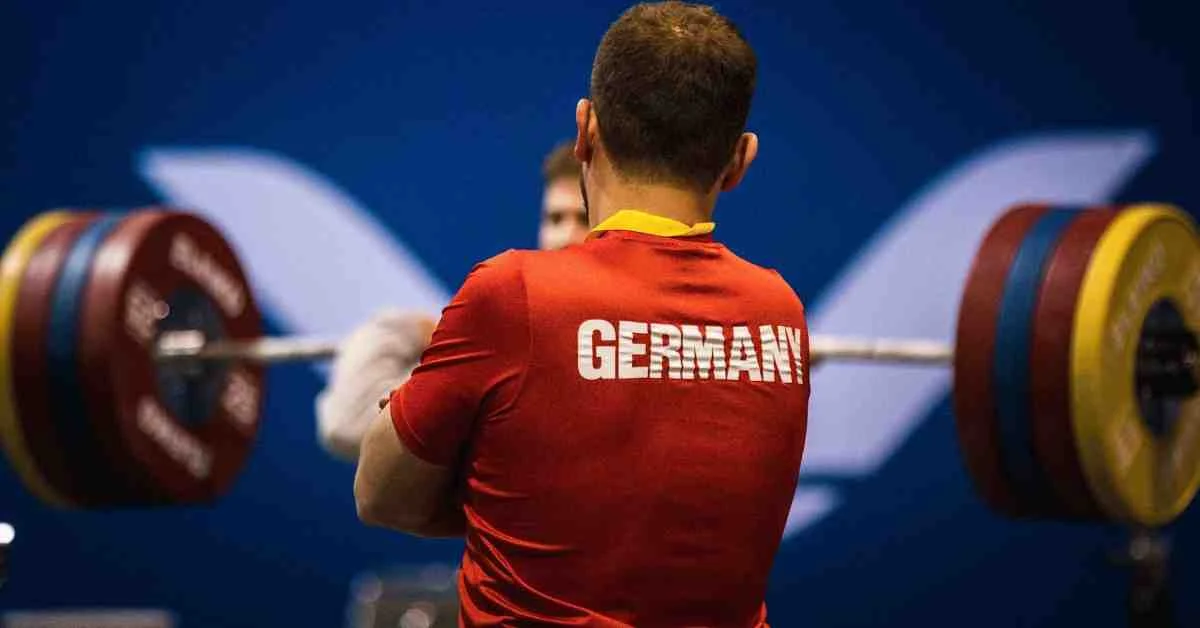Introduction
Coaching any highly technical event requires perspective. In the high jump, different perspectives are crucial to coaching the curvilinear approach effectively. I don’t mean experiential perspectives. What I mean is that you, the coach, need to observe your athlete’s performance from different vantage points around the competition area. While you can easily accomplish this task in training, the designated coaches’ box makes it more difficult in competition. When I coached high jump, I was fortunate enough to avoid relegation to a coaches’ box, and I chose select locations around the competition area to watch my athletes take their attempts. However, even with a trained coaching eye, I could not evaluate all dimensions of my jumpers’ movements. The visual limitations were challenging, but not impossible to surmount. In addition to changing vantage points, a well-defined technical model that outlines the event’s basic movements can make coaching easier by pinpointing critical components of the high jump that are worth our attention for evaluation and feedback.
Here’s where I lose the track & field evangelists who promote individualization.
A technical model should apply to any athlete, regardless of age or training age. It should be strictly biomechanical, and not verbal or psychological. In other words, a coach can cue the athlete however they see fit, as long as the athlete physically adheres to the movement patterns of the model. The movement patterns which define the high jump’s technical model are well-established, with the exception of the event’s most important movement, stride pattern prior to takeoff. When you dig through the available biomechanical research, you find that this part of the jump remains poorly analyzed. Data collected from the 2017 and 2018 World Championships reveals that stride patterns vary considerably among the world’s best athletes too. However frustrating or fruitless, this absence of evidence still offers scientific value and should not deter our advances with the current technical model. I will show you how we can use these two bodies of work to steer your coaching for the better.
Stride Pattern Matters
Stride pattern prior to takeoff determines the path of the jumper in the air and the quality of their attempt. A standardized stride pattern provides a physical framework for the athlete’s training and the coach’s feedback. Any deviations from the model require correction, which can include feedback that addresses physical movements, or the athlete’s mentality.
While an athlete’s psychological state may influence their ability to perform, it does not change the requirements for an ideal performance in line with the model itself. For example, an athlete determined to clear the bar in their final attempt might tense up for their approach. Determination may be valuable for an athlete’s mindset, but it may detract from performance in the way that it manifests physically. Tensing up may shorten an athlete’s stride, causing them to take off too far away from the bar and clip it on the way down. Compensation for fatigue might cause the athlete to overstride, which would lengthen their stride and produce the undesirable effect of taking off closer to the pit. That athlete would then clip the bar on the way up and fail their attempt. The elongated stride could also set up a poorly executed take-off. These are just a few ways that an athlete would depart the biomechanical basis of the technical model.
A Biomechanical Basis
The high jump’s curvilinear approach introduces the dimension of depth for feedback and analysis. No matter where the coach positions themself to observe their athlete’s attempt, they will miss some aspect of the approach. For example, if you watch the athlete initiate their approach from a profile view, then you could easily observe stride quality and average stride length, but it would be more difficult to observe the trunk lean angle and any changes to stride length prior to take-off. The biomechanical researcher does not have to contend with this challenge because they can view the attempt from multiple vantage points with cameras or other motion-capture devices. Many biomechanical mysteries of the high jump have been solved, but stride pattern prior to take-off is not one of them.
Video: High Jump Trunk Lean Perspective
Dapeña, Ae & Iiboshi (1997) refined a previous “design for the run-up” with data from the 1991 World Championships and 1992 Summer Olympics. They captured footprints from several athletes and demonstrated that the jumper’s final footprint (take-off step) drifted slightly outside the average curve. Their study aimed to “fit a curve to the footprints,” and measured variables, like trunk angle, velocity, and curve radius, but fell short of identifying any apparent patterns in the length of or relative length of the final strides. I found this omission surprising since stride length is also a determining factor for the placement of the last “footprint” and its deviation from the curve. The 1997 Dapeña study suggests a better model for the curvilinear approach, but it does not explain why the last footprint’s deviation from the curve is physically advantageous for take-off.
The late Dr. Jesus Dapeña was a high jumper himself, and became one of the world’s leading high jump researchers. In 2007, he and co-author Travis Ficklin published a 136-page report that reviewed technique and recommended adjustments for the athletes involved in the study. The report, titled High Jump #32, was commissioned by USATF, and seemingly represents everything Dapeña had learned from years of research. Specific to stride pattern, Dapeña and Ficklin recommend a shortened penultimate and final stride. They also recommend that the athlete increase their knee flexion during both strides to prepare for the take-off. Though Dapeña’s conclusions rest upon troves of data, reasonable modeling, and sound analysis, his stride pattern recommendation remains weakly supported. To Dapeña’s credit, I’m not entirely convinced he’s wrong, but neither am I willing to accept any conclusion without its necessary, scientific due process.
Maybe the data is out there and I haven’t encountered it. Maybe the right variables haven’t been correlated yet. I’m not comfortable arguing one way or the other, without the data, for a standardized stride pattern. I wish I could tell you definitively that having long legs means you should stride short-long at takeoff; or, alternatively, that with shorter legs your final strides should be short-short. It’s possible that, regardless of body proportions, every athlete should stride in the same way prior to take-off. My objectivity prevents me from drawing a conclusion in favor of one over the other. My subjectivity reminds me that these unknowns are still no excuse for individualization, or masking bad habits as an athlete’s “style.” A lack of data should simply inspire us to explore further.
A Little History
Since the Olympics’ revival in the 1890’s, there have been several technical models utilized for clearing the bar. Only one remains in use widely today. In 1968, Dick Fosbury introduced the world to his new jumping technique and forever changed the sport after winning the gold medal. Fosbury combined the curvilinear approach of the parallel straddle with the center of mass lowering utilized in the Western Roll. The Fosbury Flop, or just “The Flop,” was unusual because nobody had ever jumped that high over the bar with their back to it—the curvilinear approach also widened.
Fosbury’s innovation was his bar clearance strategy. When you watch his approach, he doesn’t change his stride significantly before take-off. When you watch Javier Sotomayor and Mutaz Barshim, they shorten both of their last two strides. In most competition videos, we observe Bogdan Bondarenko elongate his last stride. In his best jump from the 2018 WC, Bondarenko shortens his last stride. I accept The Flop as the high jump’s technical model, but not all of its movement patterns are fully understood, or absolved of further scrutiny.
The ideal stride pattern prior to take-off, or how a jumper transitions from horizontal to vertical, remains unresolved.
By all accounts, the 2017 and 2018 World Championship Biomechanical Reports provide a robust overview of variables from the high jump and demonstrate that measures of elite performance exist within predictably narrow ranges. For example, at the 2017 WC in London, whole body lean at the toe-down of the final step ranged between 31-40 degrees for the women and 35-45 degrees for the men. Those 21 athletes, and their uniquely defined data points, may not pose the strongest argument for body positions at toe-down, but when compounded with the 2018 WC report, the argument becomes more compelling. In London 2018, 11 men maintained a range of 34-41 degrees for whole-body lean. Unfortunately, World Athletics never published a women’s high jump report in 2018, or followed up beyond those two years. A sample size of 32 athletes jumping within a 34-45 degree range says to the wider track & field community that such technique may be desirable for the event. Now, this component of a high jump technical model has greater footing (or leaning).
Even if the human eye cannot differentiate 40 from 55 degrees of body lean in the flash of takeoff, there are ways to apply this in coaching the high jump. Alignment of the athlete’s head with background objects in the competition arena could identify the angle from which the athlete toes down. A coach can then cue their athlete to lean more or less into the curve at takeoff.
In this case, whole-body lean data offers promise in building a better technical model for the high jump. While useful, though, the data is limited. Each number in the report only represents an athlete’s best performance from the competition, and even top athletes can be inconsistent. I would rather peruse the data from every attempt made by one athlete, and selectively develop an average performance model for that athlete before comparing it with other athletes. For stride pattern, the most valuable variables are exactly that—somewhat variable.
Crunching the Numbers
In the 2017 World Championships, 10 out of 12 women utilized a long-short stride pattern before take-off. Their penultimate stride elongates the stride before it and their final stride was even shorter than both the penultimate and third to last stride. The other two jumpers relied on a short-short pattern and a short-long pattern.
Video: Hannes demonstrating the long-short stride
In the men’s high jump, 5 jumpers relied on the same technique as the women with the long-short pattern. The remaining 5 elongated their final stride at takeoff, but varied their penultimate or third-to-last strides. In the 2018 WC, only 5 out of 11 men relied on a long-short pattern, while the remaining 6 men varied widely between short-short, long-long, or an elongated or shortened final stride only. If we ignore the differences in sex, and compile the WC data, we find that 20 out of 33 jumpers rely on the long-short stride pattern. This is not enough data, nor is it sufficiently convincing to support an argument for the long-short stride pattern.
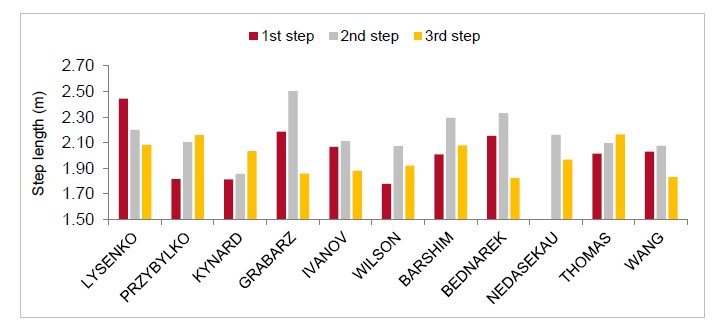
Figure 1. Length of the last three approach steps (or strides) for each of the male athletes competing in the 2018 Birmingham World Championships high jump. Bars are missing where the data was not collected.
A technical model should not emerge from a silo of data alone. After all, the data is meaningless without interpretation. Unfortunately, Dr. Dapeña’s empirical recommendation for a short-short stride pattern seems somewhat inconsistent with the favored stride pattern evident in the WC data. Both sources indicate that a shortened final stride may be desirable, but again, neither source offers enough data to draw a definitive conclusion. Furthermore, limb proportions could factor into a stride pattern that suits “speed jumpers” or “power jumpers” more appropriately. I’m yet to find a study that goes beyond biomechanical simulations on this topic.
Video: Hannes demonstrating the short-short stride
Other Perspectives and New Directions
To learn more about the two different types of high jumpers, I spoke with Coach Bob Myers, from the University of Arizona. Coach Myers participated in SimpliFaster’s Jumps Roundtable #2 and wrote an article on the topic of penultimate stride in USATF’s magazine Track Coach.
Coach Myers shared a few useful perspectives that I hadn’t considered. He explained that speed jumpers typically shorten their final stride and reduce their ground contact time at take-off, which allows them to increase the force they put into the ground. While speed jumpers attempt to decrease their ground contact time, power jumpers instead try to increase it. With a longer final stride, they’re able to conserve the angular momentum from their trail leg and time it with their takeoff to redirect it vertically.
Both strategies may be adequate, but Coach Myers indicated that most high jumpers favor speed jumping today. The WC data seems to confirm this too. The reason for this preference could be due to any number of selection biases. It could also relate to the ease with which a jumper can apply a quick, shortened take-off step. Tall athletes might also find it difficult to swing their trail leg fast enough to generate decent vertical momentum. Could be a timing issue. Whether we separate these jumping styles into one technical model or two remains irrelevant without further study. Until these styles are defined with characteristic traits, like height, limb proportions, or explosive strength, we cannot confidently assign a stride pattern to either style.
In the footsteps of Dapeña, some very interesting analyses emerged from Korea, where several universities funded high jump research. Kim et al (2011) found that the gold medal winner in the 2011 Daegu World Championship applied the shortest ground contact time and produced the highest ratio of vertical to horizontal velocity. This was most unfortunate for the bronze medal winner, who elevated their center of mass higher than the gold medal winner but applied the longest ground contact time. Was the gold medalist a speed jumper and the bronze medalist a power jumper? Can such limited data make the case for one style of jumping over another? I think not. Again, the data is not there yet. Coach Myers and I agreed that these topics deserve further attention in both open competition and controlled laboratory settings.
Coach Myers also identified another curious part of the jump worth our attention—the arm action at take-off. When Dick Fosbury jumped in Mexico City, the footage reveals that he didn’t swing his arms upward very much—and among elite jumpers today, this practice varies widely. A quick arm action timed with take-off would ideally add angular momentum and minimize the jumper’s loss of velocity. This is the biomechanical argument, and actually aligns more with power jumping than speed jumping (though we observe the practice in both styles).
To the contrary, physicists would tell you, quite emphatically, that a body in motion will follow its predetermined path based on the forces exerted when it leaves the ground. That is not an argument against using an arm action, but it’s not necessarily an argument for it either. The data simply doesn’t exist to confirm whether or not a well-timed arm action, single or double, can enhance an athlete’s angular momentum at take-off. A frame-by-frame analysis paired with an athlete’s impulse data would help resolve this compelling question. This might be a step away (pun intended) from the stride pattern, but nevertheless, it contributes to developing a technical model. Maybe Dick Fosbury could have jumped higher with more arm action? Or, maybe it would have made no difference?
Here’s what we know: Take-off matters! Jumpers produce the best performances from a take-off that preserves as much velocity as possible in the transition between ground and air. The relative length of an athlete’s stride, their trunk angle, position of their center of mass, and foot placement are all determining factors for this transition. A slight knee flexion in the take-off leg increases the elasticity of the jump and helps prevent injury. Each of these components are separate, coachable skills that require precision, and practice. Until the data directs us in a different direction, we should coach speed jumpers to shorten their final stride before take-off, and power jumpers to elongate their final stride. An athlete should shorten or elongate their last two strides by no more than 20% of their average stride length in the approach.
High jump is complex, but like all track & field events, it can be simplified down to its phases and components. Those phases should be coached in sequence and those components should be drilled for proficiency. An evidence-based technical model should also prescribe the correct drills and cues for coaching it. In all aspects of technique, the model should help us coach more efficiently and more effectively.
Take-off matters! Jumpers produce the best performances from a take-off that preserves as much velocity as possible in the transition between ground and air, says Noah Kaminsky Share on XConclusion
I’ve tried to write this article so many times in the past 4 years. The reality is that no existing data can accept or reject my hypothesis. I’ll be happy to climb down from my soapbox if and when some future study concludes that a particular stride pattern is better than another. My aim has always been to bridge the divide between the research and coaches, so that I may give more meaning to the numbers and offer some practical benefits.
The 2017 WC Biomechanical Report stated that “the challenge for the coach is to develop the technique that best suits the physical makeup of their athlete.” For now, I can see how this applies well between speed jumping or power jumping. I could be getting wrapped up in semantics, but the word “develop” really bugs me. Developing an athlete’s technique within the accepted technical model makes great sense. Developing a new technique to fit the athlete, as though they are some nuanced puzzle worthy of innovation, is a fool’s errand. Until you’ve got an athlete with unprecedented quirks or extremes, it’s not worth tolerating their technical deviations or deficiencies. You’re only fooling yourself if you accept the phrase, “It just works better for them that way.” Besides athletes with real physical challenges, whom we would consider paralympic, we share more similarities than differences, as is true across all athletic events.
Individualization gets way more credit than it deserves, especially in track & field. We all have the same bodies, with the same bones, muscles, and movement patterns. The genetic differences that do exist merely divide the elite competitors by millimeters or hundredths of a second. For that matter, the difference between speed jumping and power jumping could be razor thin too.
Individualization gets way more credit than it deserves, especially in track & field. We all have the same bodies, with the same bones, muscles, and movement patterns, says Noah Kaminsky Share on XCoach Alex Jebb, another coach in the Jumps Roundtable, recognizes that “technical models are largely the same, regardless of the athlete, because the laws of physics will dominate a large portion of these models.” In this statement, Jebb acknowledges and accepts that the path of a jumper in the air will not change once they leave the ground. He goes on to say that the “concepts of basic physiology are the next level of governance,” and “only after accounting for these two layers, physics and physiology, can we begin to interject athlete-specific modifications.” He’s absolutely right.
Our first technical models may have been built upon observation and intuition, but as they have been revised or refined, we must have the humility to let the data drive those changes. Even with the advances in artificial intelligence, I doubt anything will serve athletes better than a trained pair of eyes, because innovation will always be a human endeavor. Those two statements are not at odds with one another either. Innovations are conclusions built on data, however the data is collected, and we have to dismiss the dogma when the data points in a different direction.
If you want to know how to do something better, collect data and get to know those numbers. In Building a Better Long Jump, I argued that a long-short stride pattern at take-off is essential for the event’s technical model because the majority of elite long jumpers use that stride pattern. I also claimed that the WC Biomechanical Reports are one of our greatest resources to resolve our empirical intuitions about technique. In the high jump, this has proven more difficult. The WC data is a good start, but the data is less empowering for refining the Fosbury Flop.
I’m not arguing against innovation. We may yet discover new ways to jump higher off of one foot, and I look forward to the day that we do. Perhaps, data will lead the way. Until then, we are obligated to better understand and refine the technical models that we have. Dick Fosbury brought something fresh to the high jump because he identified a way to make old ideas new. His empiricism led to innovation, but sometimes errant empiricism can drive dogmas that are astoundingly difficult to undo. We live in an age when data and analysis can guide our coaching. It’s our charge to embrace it. The dogma days are over.
Innovation will always be a human endeavor. Those two statements are not at odds with one another either, says Noah Kaminsky Share on XResources
Dapena, J. (1988). “Biomechanical Analysis of the Fosbury Flop.” Track Technique, 104, 3307-3317.
Dapena, J., McDonald, C. and Capert, J. (1990). A Regression Analysis of High jumping technique. Journal of Sport Biomechanics. 6:246-261.
Dapena, J. (1995). How to design the shape of a high jump run-up. Track coach, 131, 4179-4181.
Dapena, J., Ae, M., & Iiboshi, A. (1997). A closer look at the shape of the high jump run-up. Track Coach, 138, 4406-4411. https://sportbm.publichealth.indiana.edu/paper-hj-1997.pdf
Dapena, J. (2000). The high jump. Biomechanics in Sport: Performance Enhancement and Injury Prevention, 284-311.
Dapena, J. (2002). The evolution of high jumping technique: biomechanical analysis. In ISBS-Conference Proceedings Archive. Volume 10, Issue 4. May 2017.
Isolehto, J., Virmavirta, M., Kyrolainen, H., & Komi, P. (2007). Biomechanical analysis of the high jump at the 2005 IAAF World Championships in Athletics. New Studies in Athletics, 22(2), 17.
Jonas, Dusty. High Jump Approach Mapping – A New Way to Develop A Consistent High Jump Approach. Techniques Magazine,
Kim, E. H., Bae, Y. S., Kim, S. S., Kwon, M. S., Wi, U. R., KIm, K. M., & Lee, J. M. (2011). Biomechanical analysis of men’s high jump medalists in iaaf world championships, daegu 2011. Korean Journal of Applied Biomechanics, 21(5), 573-584.
https://koreascience.kr/article/JAKO201128448584633.pdf
Myers, Bob. (1989). Improving the penultimate step in the jumping events. New Studies in Athletics, 4(3),73-77. https://centrostudilombardia.com/wp-content/uploads/IAAF-Salti-Generale/1989-Improving-the-penultimate-step-in-the-jumping-events.pdf
Newman, Nick. The Jumps Roundtable #2: Building a Technical Model. Simplifaster Sports Technology Blog. https://simplifaster.com/articles/jumps-technical-model/
Newman, Nick. The Jumps Roundtable #2: Working with New Athletes. Simplifaster Sports Technology Blog. https://simplifaster.com/articles/jumps-roundtable/
Nicholson, G., et al. (2019). Biomechanical Report for the IAAF World Indoor Championships Birmingham 2018: High Jump Men. International Association of Athletics Federations.
Nicholson, G., et al. (2018). Biomechanical Report for the IAAF World Indoor Championships London 2017, High Jump Men’s. International Association of Athletics Federations.
Nicholson, G., et al. (2018). Biomechanical Report for the IAAF World Indoor Championships London 2017, High Jump Women’s. International Association of Athletics Federations.
Schiffer, J. (2009). The high jump. New Studies in Athletics, 24(3), 9-22.

